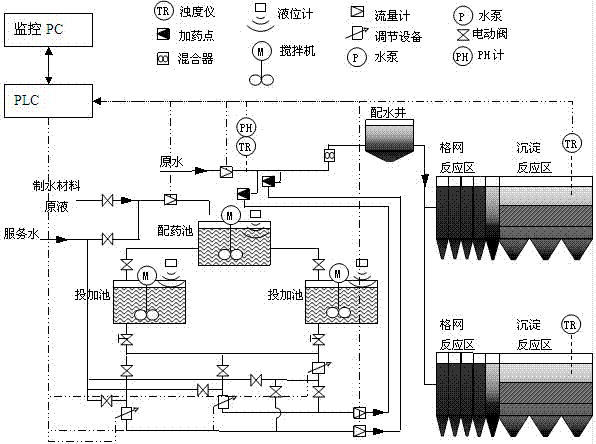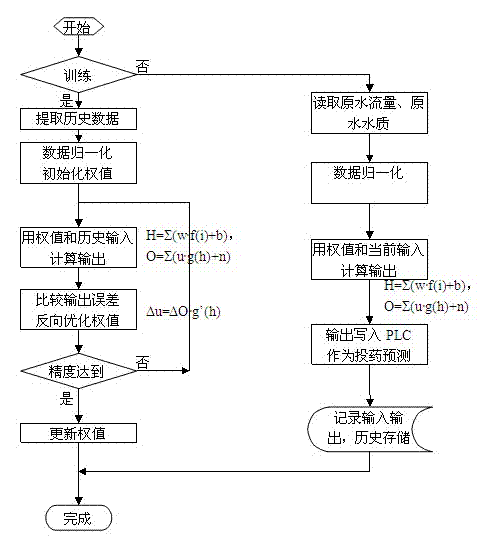Method for controlling automatic chemical dosing of high-turbidity water system
A control method and high turbidity technology, which is applied in the direction of flocculation/sedimentation water/sewage treatment, etc., can solve the problems of inability to obtain better sedimentation effect, dosing control, inability to adapt to changes in water quality of high turbidity water systems, etc.
Inactive Publication Date: 2013-04-03
CHONGQING WATER GROUP
View PDF5 Cites 54 Cited by
- Summary
- Abstract
- Description
- Claims
- Application Information
AI Technical Summary
Problems solved by technology
Although FCD (Flower Imaging Analysis Feedback Control System), SCD (Flowing Charge Detection Feedback Control System), flow feedforward control and other automatic dosing controls a
Method used
the structure of the environmentally friendly knitted fabric provided by the present invention; figure 2 Flow chart of the yarn wrapping machine for environmentally friendly knitted fabrics and storage devices; image 3 Is the parameter map of the yarn covering machine
View moreImage
Smart Image Click on the blue labels to locate them in the text.
Smart ImageViewing Examples
Examples
Experimental program
Comparison scheme
Effect test
 Login to View More
Login to View More PUM
 Login to View More
Login to View More Abstract
A method for controlling the automatic chemical dosing of a high-turbidity water system trains a back propagation (BP) neural network according to the operation parameters of the flow, turbidity, temperature and pH value of historic source water, the outlet water turbidity of a sedimentation tank and the like, so that a neural network model is obtained, the parameters are then used as the input parameters of the BP neural network, an internal optimization algorithm of the BP neural network is utilized to obtain an output for guiding and controlling the chemical dosing amount, an internal model proportion integration differentiation (PID) algorithm is used to adjust the chemical dosing amount according to the turbidity of the sedimentation outlet water in real time, a flowmeter and a liquid level meter are utilized to accurately control the dosage concentration, the addition flow is calculated according to the dosage concentration and addition dose, PID control is carried out to regulate valve opening or dosing pump frequency according to the flow, and thus, the dosing flow is controlled. According to the method, the dose can be adjusted quickly according to the water source variation, the outlet water turbidity of the sedimentation tank can also be tracked automatically to appropriately correct, thus, the outlet water turbidity index of the sedimentation tank meets technological requirements, and the medicine consumption is also saved.
Description
technical field [0001] The invention relates to an automatic dosing control method in the urban water supply industry. Background technique [0002] The dosing system of the waterworks is an important process in the water production process. The purpose is to make the impurity particles in the water collide and coagulate with the coagulant added, and through electrical neutralization, adsorption bridging and rolling The sweeping action turns the colloid in the water into flocculated particles, which are quickly precipitated through the sedimentation tank. The factors affecting the effect of coagulation and sedimentation are relatively complex, mainly including water temperature, pH value, the nature and concentration of impurities in water, hydraulic conditions, etc. These elements are aspects that need to be considered when designing an automatic dosing system. [0003] At present, the design idea of most automatic dosing systems is based on the ratio of raw water inflow...
Claims
the structure of the environmentally friendly knitted fabric provided by the present invention; figure 2 Flow chart of the yarn wrapping machine for environmentally friendly knitted fabrics and storage devices; image 3 Is the parameter map of the yarn covering machine
Login to View More Application Information
Patent Timeline
 Login to View More
Login to View More IPC IPC(8): C02F1/52
Inventor 张元禾韩兴连岳敏王俊蒋绍阶田胜海周光明
Owner CHONGQING WATER GROUP
Features
- R&D
- Intellectual Property
- Life Sciences
- Materials
- Tech Scout
Why Patsnap Eureka
- Unparalleled Data Quality
- Higher Quality Content
- 60% Fewer Hallucinations
Social media
Patsnap Eureka Blog
Learn More Browse by: Latest US Patents, China's latest patents, Technical Efficacy Thesaurus, Application Domain, Technology Topic, Popular Technical Reports.
© 2025 PatSnap. All rights reserved.Legal|Privacy policy|Modern Slavery Act Transparency Statement|Sitemap|About US| Contact US: help@patsnap.com



